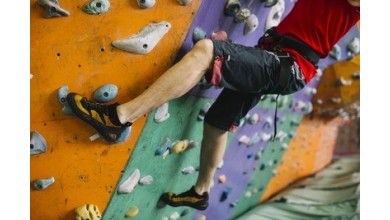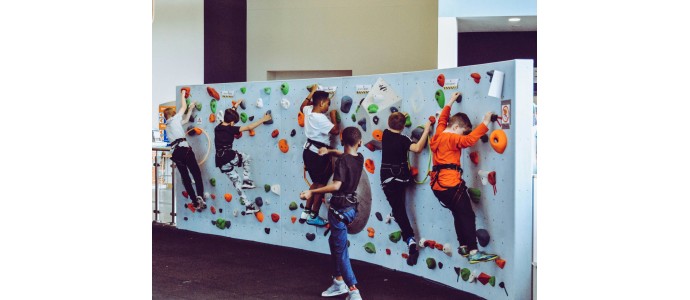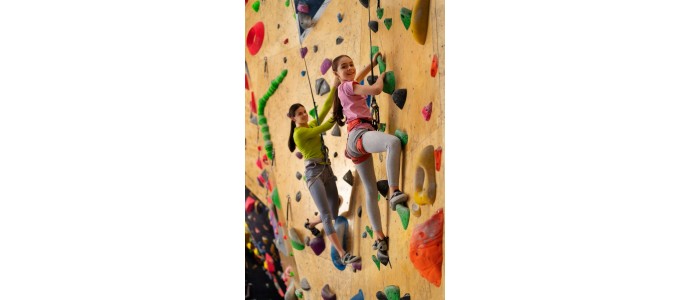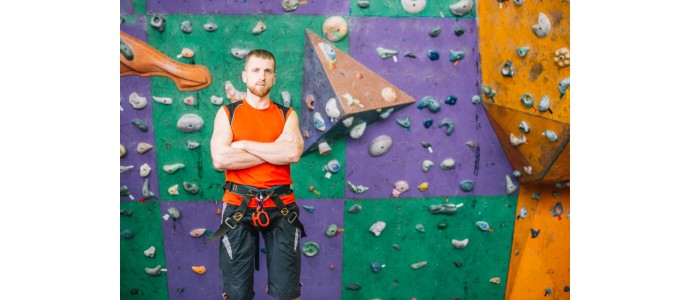Tips for Designing an Efficient and Functional Climbing Wall
A climbing wall is a space specially designed for the practice of climbing. Designing an efficient and functional climbing wall requires planning and attention to detail.
Tips for designing an Efficient and Functional Climbing Wall
A climbing wall is a space specially designed for the practice of climbing. Designing an efficient and functional climbing wall requires planning and attention to detail. In this article, we explore the key elements and tips for creating a safe, efficient and enjoyable climbing space for both beginners and experienced climbers.
Planning of climbing wall
Choosing the right location
As a climbing expert, I know that choosing the right location is critical to the success of a climbing wall. First, it is important to consider accessibility and available space. For an indoor climbing wall, the location should be easily accessible to both beginners and experienced climbers. This includes considering whether you are near a main road or public transportation, and if you have parking available.
The space should also be large enough to install walls of different sizes and angles. This will allow climbers to enjoy varied and challenging routes. Here are some important factors to consider:
- Size of the space:
- Determine how many walls you can install.
- Consider the heights of the roofs, especially if you want to include rope climbing routes.
- Shape of space:
- Make sure the space has open and unobstructed areas for climbing walls.
- Irregular spaces may be more difficult to use efficiently.
- Visibility:
- The location must be visible and attractive to attract climbers.
- The space should allow enough natural light to create a pleasant atmosphere.
Layout of climbing wall
The layout design of the climbing wall is equally crucial to creating an efficient flow between different areas and ensuring that climbers have a pleasant experience. Here are some guidelines for layout design:
- Creating an Efficient Flow:
- Organization of the Areas:
- Divide the climbing wall into functional areas, such as climbing zones, rest areas, changing rooms and reception.
- Transit direction:
- Make sure that climbers can easily move from one area to another.
- Consider using signs and demarcations on the ground to guide traffic.
- Include Warm-up and Rest Areas:
- Heating areas: Water
- These areas should be near the climbing areas.
- Includes training equipment such as bars and mats.
- Rest areas:
- Provides comfortable seating for climbers.
- Consider including tables so that climbers can relax and socialize.

Selection of Materials for Climbing Wall
Materials for climbing panels
As a climbing expert, I have seen how the choice of the right materials can influence the climbing experience and durability of the climbing wall. Climbing boards are the main component of any climbing wall and can be made from various materials, such as plywood, recycled plastic, aluminum, and others.
- Plywood:
- Advantages:
- It is a traditional and easy to work material.
- Provides a good surface for securing climbing prey.
- Disadvantages:
- May be prone to moisture and wear over time.
- Common Uses:
- Indoor climbing walls and climbing walls in gyms.
- Examples:
- School climbing walls or small gyms.
- Recycled plastic:
- Advantages:
- It is durable and weatherproof.
- Offers good texture and grip.
- Disadvantages:
- May be more expensive than other materials.
- Common Uses:
- Outdoor climbing walls and climbing walls in shopping malls.
- Examples:
- Climbing walls in parks or outdoor facilities.
- Aluminium:
- Advantages:
- It is lightweight and corrosion resistant.
- Can withstand heavy loads.
- Disadvantages:
- May be more expensive and less common.
- Common Uses:
- Climbing walls and competition climbing walls in high-end gyms.
- Examples:
- Climbing walls in international competitions.
Climbing Holds
Selecting the right climbing holds is essential to creating a challenging and fun climbing wall. Hold come in different shapes and sizes, allowing you to create varied routes adapted to all skill levels.
- JUGS: They are the largest and most comfortable of the ceiling. They are grips that allow us to close our hand completely. They are very common in the stages of initiation or in slumps to rest.
- SLOPER: It is the type of hold defined by a grip with the hand more or less open. It requires a large overall compression force of the whole open hand.
- EDGES: It is the most desired type of hold, the most classic grip. They are small edges usually for the first phalanx. They are the favorite of the most fanatics.
- PINCHES: They are holds in which you can use the thumb opposite to the rest of fingers to generate all the force on the hold. They are also the most sought after for the most demanding workouts.
- POCKETS: One-finger, two-finger or three-finger. They are holes in which you can put only 3 fingers. This type of prey is characterized by a type of grip in extension since its shape prevents the grip in balance.
Hold Sizes:
- Small: Sizes (XXS or Feet, XS and S). They require precision and strength.
- Medium: Sizes (M and L). They offer a good balance between size and difficulty.
- Large: Sizes (XL, XXL and MEGA). They are comfortable and easy to grip.
Material of climbing holds:
- Polyurethane resin (PU) It is resistant and light. Currently the most used and desired.
- Polyester (PE) resin: It is durable but heavier.
- Wood: It is soft but can wear out faster.
- Glass fibre: Glass fibre: Very light but somewhat fragile if struck or fall. Used for large hold called volumes or macros.
- Recycled thermoplastic: Very light and much more resistant to shocks and falls. Currently it has been a revolution in volumes and macros.
Comparative Table: Climbing holds
|
Tipe of hold |
Characteistics |
Difficulty |
|
Crimp |
Narrow and challenging |
High |
|
Jug |
Big and comfy |
low |
|
Sloper |
Rounded and slippery |
Medium |
|
Pinches |
Narrow and challenging |
Medium |
|
Pockets |
Narrow and challenging |
High |
Lighting and Decor
The lighting and decoration of the climbing wall plays a crucial role in creating a safe and welcoming environment for climbers. Here are some tips to get it right:
- Lighting:
- Natural light: Use natural light whenever possible.
- Artificial light:Use LED lights to reduce glare. Place lights so that they do not create shadows on the routes.
- Decoration:
- Colors: Choose vibrant colors for an energetic atmosphere. Use relaxing tones for a calm atmosphere.
- Topics: Incorporate climbing or mountaineering themes in the decoration.
Safety in Climbing gym
Safety equipment
As a climbing expert, I can say that safety is one of the main concerns at a climbing wall. To ensure a safe environment for all climbers, it is crucial to have the right safety equipment. Here are some essential elements:
- Mattresses:
- Crash pads are essential to absorb the impact of falls.
- Must be evenly distributed under all climbing areas.
- The mats should be thick and strong, with a non-slip surface.
2. Ropes:
Climbing ropes must be strong and durable.
It is advisable to use dynamic ropes, which absorb part of the impact in case of fall.
Ropes should be regularly inspected and replaced if damaged.
3.Safety Devices:
Safety devices include safes, carabiners and express tapes.
It is important that these devices are of high quality and well maintained.
Ensure that the equipment is suitable for the type of climbing to be practiced.
Before opening the climbing arena to the public, extensive safety tests must be performed. This includes:
Check that all equipment is in good condition.
Test routes to ensure that dams are well secured and routes are safe.
Train staff in the use of safety equipment and how to respond to emergencies.
Supervision and maintenance
Supervision and maintenance are crucial to keep the climbing wall in optimal condition and ensure the safety of climbers.
Supervision:
- The climbing wall should have trained and qualified personnel.
- Supervisors should monitor the behavior of climbers to make sure they follow safety rules.
- Staff should also be available to help climbers with equipment and respond to any problems.
Maintenance:
- Regular maintenance is crucial to detect and resolve problems before they become risks.
- Regular inspections of dams, panels, and safety equipment should be carried out.
- Any defective or worn equipment should be repaired or replaced immediately.
Creating a Welcoming Atmosphere
Rest and Services Areas
As a climbing expert, I know how important it is to create a welcoming environment for climbers. Rest and service areas are essential for climbers to relax and recover between ascents. Including elements such as changing rooms, bathrooms, and rest areas can make the climbing wall more attractive and comfortable.
Changing rooms:
Changing rooms are needed for climbers to change clothes before and after climbing.
It is important that the changing rooms are spacious and equipped with benches, coat hangers and showers.
Keeping changing rooms clean and well ventilated is essential for the comfort of users.
Bathrooms:
Baths are a basic necessity in any climbing wall.
They should be kept clean and stocked with toilet paper and soap.
It is recommended to include both male and female toilets as well as toilets for disabled people.
Rest areas:
The rest areas provide climbers with a place to relax and socialize.
They should be equipped with comfortable chairs, tables, and sofas.
It is a good place to include hangers or hooks so that climbers can hang their backpacks and equipment.
Snacks and drinks:
Offering refreshments and drinks is a great way to enhance the experience for climbers.
Vending machines or a coffee shop can be installed to provide healthy and energizing options.
It is important to provide drinking water so that climbers can stay hydrated.
Promoting Socialization
The environment in a climbing wall is not only about climbing, but also about socializing. Encouraging interaction between climbers can improve their experience and create a strong community. Here are some ways to promote socialization:
Group Events and Activities:
Organizing group events and activities is a great way to encourage interaction.
Events may include friendly competitions, climbing classes, and social events.
These activities give climbers the opportunity to meet and share their love of climbing.
Common Spaces:
Creating common spaces where climbers can meet and talk is important for socialization.
These spaces may include sitting areas, tables and chairs.
Decorating these spaces in a welcoming and attractive way can encourage climbers to spend time there.
Promoting the Community:
Fostering a sense of community can help climbers feel connected and valued.
This may include things like a achievements wall, where climbers can share their successes, or a bulletin board to share information about events and activities
Promoting an inclusive and friendly environment is key to creating a community of committed climbers.
Continuous Improvement and Fun at the Climbing Wall
Monitor the Performance
As a climbing expert, I know that keeping up with continuous improvement and fun at a climbing wall is key to keeping climbers motivated and satisfied. Performance monitoring is an effective strategy to assess climber satisfaction and adjust the climbing design according to your needs.
Assessing Climber Satisfaction:
Surveys and feedback:
Conducting surveys of climbers is a great way to get their feedback.
Asking about the difficulty of routes, quality of equipment, and overall experience can provide valuable information.
Analysis of use:
Analyzing which routes are most popular and which ones are avoided can help adjust the climbing wall design.
Observing the time climbers spend in different areas can also indicate which parts of the climbing wall need improvement.
Adjust the Design as Required:
New Redesign Routes
If climbers find certain routes too easy or difficult, they can be adjusted to offer a suitable challenge.
Upgrade the Equipment:
Replacing or upgrading equipment can improve the experience of climbers.
Modify the Space:
Changing the layout of the space, such as adding rest areas or rearranging routes, can make the climbing wall more functional and comfortable.
Innovating and Improving Routes and Facilities
Innovation is essential to keep a climbing wall interesting and fun. Here are some ways to innovate and improve routes and facilities:
New routes:
Add Thematic Routes:
Creating routes with fun or challenging topics can make climbing more exciting.
Change Routes Regularly:
Changing routes every now and then can keep climbing fresh and challenging.
Enter Competition Routes:
Creating competition routes can attract more advanced climbers and encourage improvement.
Improvement of facilities:
- Upgrade the Equipment:
- Keeping equipment up to date and in good condition is crucial for safety and satisfaction.
- Improving the Lighting:
- Improving lighting can make climbing walls more welcoming and safe.
Add Services:
Including services such as a cafeteria or equipment store can improve the experience for climbers.
Diversification of activities
Diversifying activities in a climbing arena can attract different types of climbers and keep existing ones interested.
Offer Different Climbing Styles:
Boulder:
The bouldering is a popular form of climbing that does not require ropes or harnesses.
Offering bouldering routes can attract climbers looking for a physical and technical challenge.
Sport Climbing:
Sport climbing with ropes and harnesses is ideal for climbers looking for longer, more challenging routes.
Speed Climbing:
Speed climbing is an exciting form of competitive climbing.
Offering speed routes can attract climbers looking to improve their time and compete with others.
Offer other activities:
Yoga:
Yoga is an excellent complementary activity to climbing, helping to improve flexibility and concentration.
Pilates:
Pilates is ideal for improving core strength, which is important for climbing.
Functional Training:
Functional training can help climbers improve their strength, endurance, and balance.




.jpg)





Comments
No comment at this time!
Leave your comment